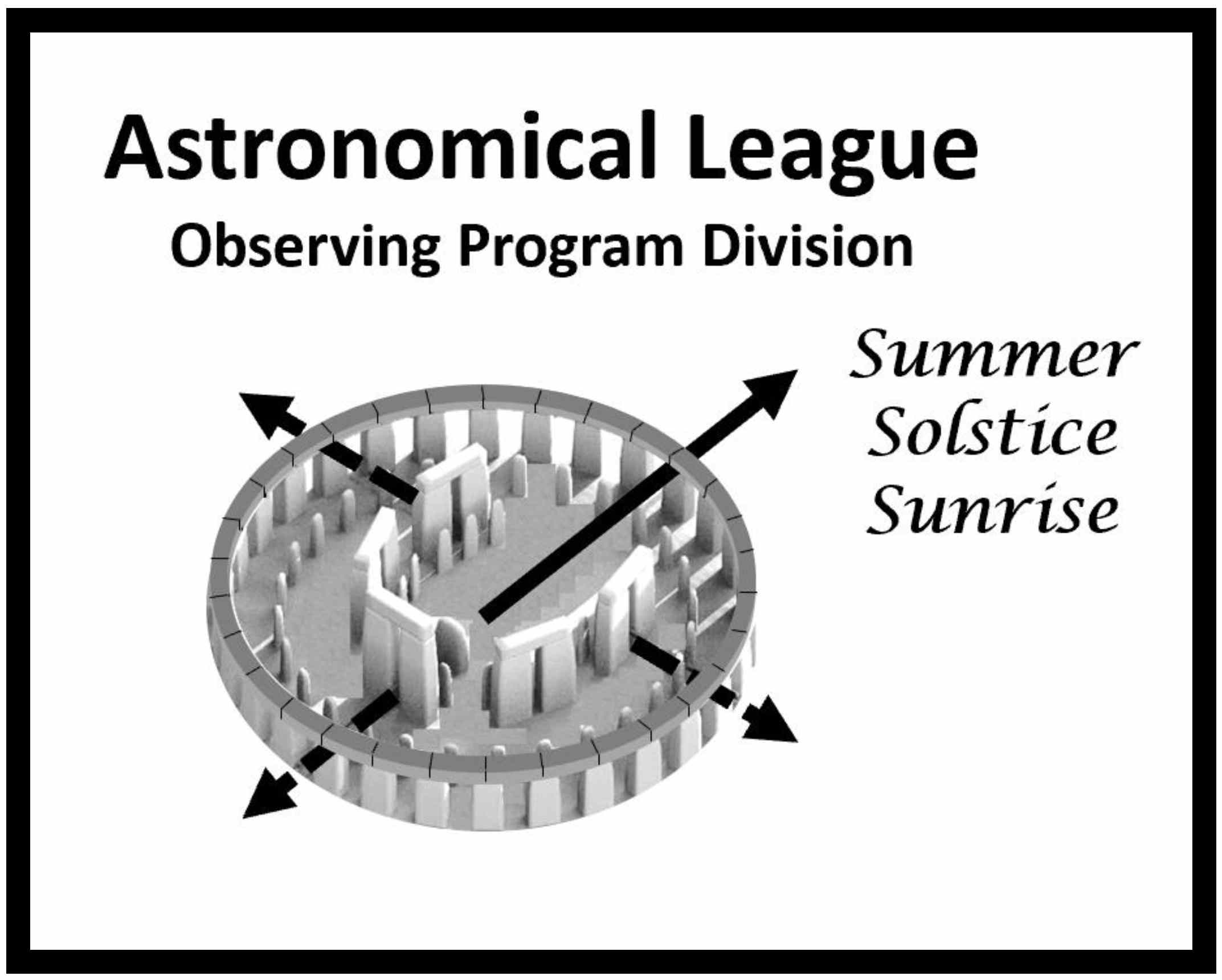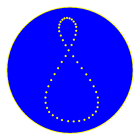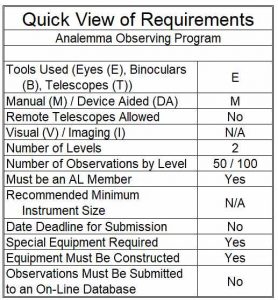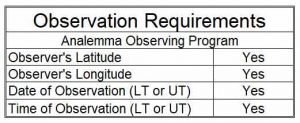Analemma Observing Program Coordinator:Douglas Smith |
  |
IntroductionJust about everyone knows that the Sun’s altitude at culmination, the highest point above the observer’s horizon, varies throughout the year – higher in the summer, and lower in the winter. However, outside of navigators, cartographers and astronomers, it is not commonly realized that the Sun’s apparent angular velocity also varies – sometimes “fast” (west of the Meridian at Local Noon), and sometimes “slow” (east of the Meridian at Local Noon). Participants in the Analemma Observing Program will monitor the Sun’s motion throughout the year and note changes in the Sun’s position, both in altitude and azimuth. They will then, with reference only to their analemma and observing apparatus:
|
 |
Requirements and Rules
This certification is available to members of the Astronomical League, either through their local astronomical society or as members at large. If you are not a member and would like to become one, check with your local astronomical society, search for a local society on the Astronomical League Website, or join as a Member-at-Large .
To qualify for the AL’s Analemma Observing Program certificate and pin, you need to generate an analemma and analyze the data of the analemma by completing the four “activities” listed below in their prescribed order.
|
 |
DO NOT ATTEMPT DIRECT OBSERVATIONS OF THE SUN! Due to hazards associated with direct observation of the Sun, only indirect observations will be accepted. Submissions using direct observations of the Sun will be rejected. Looking at the sun can cause permanent damage to your eyes.
Though not necessary to observe on specific days, both the Vernal and Autumnal Equinox, both the Summer and Winter Solstice, and the days of perihelion and aphelion should be noted on the analemma. The Observer’s Latitude, Longitude, and Local Observing Date and Time should also be noted.
IT IS STRONGLY RECOMMENDED THAT YOU CONTACT THE PROGRAM COORDINATOR PRIOR TO STARTING THIS PROGRAM TO REVIEW PROCEDURES, GET TIPS AND ASK TO GET ANSWERS TO ANY QUESTIONS
Some pre-observing activity is required:
- Select your observing site. The site must allow full-year observation of the Sun – either a ray through a hole in an obstruction, or a shadow. You will need to obtain the site’s Latitude, Longitude, and Magnetic Variation (if you use a magnetic compass to identify true north/south). The purpose of “starting with the answer” for these pre-observing activities is to assure the observations will fit on the chosen media … nothing more; once the analemma is complete, the analysis of the analemma is to be completed with reference only to the analemma and measured dimensions of the observing apparatus. All observations need to be made at the selected observing site. Observers located in a tropical location (tropical being defined as between the Tropic of Cancer and Tropic of Capricorn) should read through Appendix D. Observers located in a polar location (polar being defined as N of the Arctic circle or South of the Antarctic circle) will be unable to complete this program as the Sun is not visible for the entire year. (I would be very interested if anyone is able to develop a method of performing the required measurements using only a partial analemma curve.)
- Specify your Observing Date and Time: Most observers will find it least complicated to record their observations at Local Noon; it can be calculated from the Observing Site’s Longitude and should be calculated to the second. A source for accurate times (e.g., W W V or a cell phone) is required to ensure that the observations are taken at the same clock time (even when using a small enclosure, being off by 15-20 seconds makes a small but noticeable change in the observed position of the Sun). Be sure to add 1 hour when Daylight Savings Time is in effect. All observations need to be made at the selected observing site and all observations should be made at the same time of day.
Observers, who find it impractical to return to their observing location at Local Noon over the year, may choose between two alternatives:
- They may take readings within three hours of Local Noon, and use a published (e.g., map-derived) value for their Observing Latitude to calculate how their points would have appeared at Local Noon. They should then complete the four Activities, in their prescribed order, using the calculated Local Noon points. For an overview of how to use non-Local Noon observations, click here (Appendix B).
- They may set up a camera for unattended operation, photograph the area where they expect the indication to be, and determine the distances from the image. Observers are cautioned about several inherent weaknesses of this technique:
- These images will likely contain distortion (i.e., scaling factors will vary across the image) due to curvilinear perspective; wide-angle lenses should not be used as they increase the severity of this effect
- Automatic exposure control may washout surface markings used to locate the analemma point
- The Field of View will change if the camera is moved
- The accuracy of locating individual analemma points decreases as the camera angle shallows (here, “camera angle” refers to the angle downward from horizontal that the camera is pointing … 0° denotes pointing horizontally, and 90° denotes pointing vertically downward); observers should not attempt to use camera angles less than 60°
Observers are required to develop their technique for accurately determining distances to the individual analemma points.
Reminder: Observers using a photographic technique are required to collect a minimum of 100 data points, spread approximately uniformly throughout the year.
- Specify your observing apparatus: If using a transmitted light ray or shadow for your observations, a box containing a sheet of paper can be constructed – for a procedure to build such a box, click here (Appendix A … There are many ways to cast a light ray or shadow; this is only one of them). The points of the analemma are to be marked during the year, with the points of Solstices, Equinoxes, and aphelion and perihelion identified on the analemma.
- Note: The date of all observations will be required to do the calculations.
When the Analemma is complete, a number of parameters about the Earth and its journey around the Sun are to be calculated. The following four activities are to be done in their prescribed order:
- Activity #1: with reference only to your analemma and measured dimensions of your observing apparatus, calculate (1) the tilt of the Earth’s axis off the normal (i.e., the perpendicular vector) to its orbital plane, and (2) your observing latitude.
For a recommended calculation procedure, click here (Appendix F)
- Activity #2: with reference only to your analemma and measured dimensions of your observing apparatus, calculate the Sun’s path in the sky and produce a sketch or plot to depict that path.
For a recommended calculation procedure, click here (Appendix G)
- Activity #3: with reference only to your analemma and measured dimensions of your observing apparatus, calculate the Equation of Time curve across the year.
For a recommended calculation procedure, click here (Appendix H).
- Activity #4: with reference only to your analemma and measured dimensions of your observing apparatus, calculate the eccentricity of the Earth’s orbit.
For a recommended calculation procedure, click here (Appendix I).
Submitting for Certification
|
 |
Include with your submission, your name as you want it to appear on the certificate, mailing address, phone number, email address, and society affiliation.
Upon verification of your submission and of your active membership in the Astronomical League, your recognition (certificate, pin, etc.) will be sent to you or to the awards coordinator for your society, as you specified. Your name will also appear in an upcoming issue of the Reflector magazine and in the Astronomical League’s online database. Congratulations. Good luck with your next observing challenge.
Analemma Observing Program Coordinator:
Notes:
Acknowledgements:
We would like to make special note of the amateur astronomer who put this Analemma Observing Program together; Lowell Martin. Thank you Lowell, for providing this program that challenges not only our observing skills in a whole new way but also challenges our thinking and understanding about the mechanics of how the Earth-Sun system really works.
Links:
- Find Your Observing Program Award
- Appendix A – Construction of an Enclosure
- Appendix B – Overview of Non-Local Noon Observing
- Appendix C – Unattended Photography
- Appendix D – Corrections for Observing from Tropical Latitudes
- Appendix E – * * * Reserved for Future Use * * *
- Appendix F – Activity #1 (Tilt of Earth’s Axis and Observer’s Latitude)
- Appendix G – Activity #2 (Path of the Sun in the Sky)
- Appendix H – Activity #3 (Equation of Time)
- Appendix I – Activity #4 (Eccentricity of Orbit)



